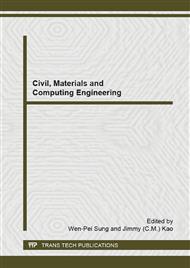p.70
p.75
p.79
p.83
p.88
p.95
p.99
p.103
p.110
Ferri-Magnetic Sorbents of Heavy Metals and Radionuclides on Base of Humates, Isolated from Oxidized Coals
Abstract:
The results of synthesis and researches of hybrid gumic-magnetic composites are presented in the article. The possibility of regulation of quantitative speciation of composites (containing of Fe) is established at the variation of proportions Fe (II), Fe (III)/HA and the way of reagents injection in a reaction mixture. The possibility of designing of sorbents on the basis of humic acids and chemically connected particles of iron oxides as magnetic-active components for fixation and extraction of heavy metals ions and radionuclides from natural objects by means of magnetic separation is shown. The adsorption degree stands at 95% in an optimal mode.
Info:
Periodical:
Pages:
88-94
Citation:
Online since:
December 2014
Keywords:
Price:
Сopyright:
© 2015 Trans Tech Publications Ltd. All Rights Reserved
Share:
Citation:


